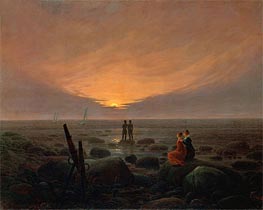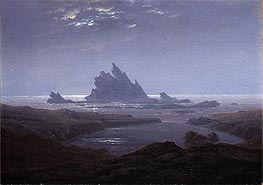The Polar Sea (The Sea of Ice), c.1823/24 by Caspar David Friedrich
Canvas Print - 2908-FCD
Location: Hamburger Kunsthalle, Hamburg, GermanyOriginal Size: 96.7 x 126.9 cm
Giclée Canvas Print | $62.9 USD
Your Selection
Customize Your Print
By using the red up or down arrows, you have the option to proportionally increase or decrease the printed area in inches as per your preference.
*Max printing size: 31.5 x 41.3 in
*Max framing size: Long side up to 28"
"The Polar Sea (The Sea of Ice)" will be custom-printed for your order using the latest giclée printing technology. This technique ensures that the Canvas Print captures an exceptional level of detail, showcasing vibrant and vivid colors with remarkable clarity.
Our use of the finest quality, fine-textured canvas lends art reproductions a painting-like appearance. Combined with a satin-gloss coating, it delivers exceptional print outcomes, showcasing vivid colors, intricate details, deep blacks, and impeccable contrasts. The canvas structure is also highly compatible with canvas stretching frames, further enhancing its versatility.
To ensure proper stretching of the artwork on the stretcher-bar, we add additional blank borders around the printed area on all sides.
Our printing process utilizes cutting-edge technology and employs the Giclée printmaking method, ensuring exceptional quality. The colors undergo independent verification, guaranteeing a lifespan of over 100 years.
Please note that there are postal restrictions limiting the size of framed prints to a maximum of 28 inches along the longest side of the painting. If you desire a larger art print, we recommend utilizing the services of your local framing studio.
*It is important to mention that the framing option is unavailable for certain paintings, such as those with oval or round shapes.
If you select a frameless art print of "The Polar Sea (The Sea of Ice)" by Caspar David Friedrich, it will be prepared for shipment within 48 hours. However, if you prefer a framed artwork, the printing and framing process will typically require approximately 7-8 days before it is ready to be shipped.
We provide complimentary delivery for up to two unframed (rolled-up) art prints in a single order. Our standard delivery is free and typically takes 10-14 working days to arrive.
For faster shipping, we also offer express DHL shipping, which usually takes 2-4 working days. The cost of express shipping is determined by the weight and volume of the shipment, as well as the delivery destination.
Once you have added the paintings to your shopping cart, you can use the "Shipping estimates" tool to obtain information about available transport services and their respective prices.
All unframed art prints are delivered rolled up in secure postal tubes, ensuring their protection during transportation. Framed art prints, on the other hand, are shipped in cardboard packaging with additional corner protectors for added safety.
Painting Information
Caspar David Friedrich's "The Sea of Ice" is less of a Romantic reverie and more of an unflinching look at nature’s ability to reduce human arrogance to rubble - or in this case, a pile of shattered ice floes. Friedrich, the ever-morose maestro of melancholy, has taken a perfectly good disaster and turned it into something borderline operatic. You don’t just look at this painting; you feel the cold creeping into your bones, the sheer indifference of the frozen wasteland.
So, Friedrich goes out to the Elbe, and what does he find? Ice. Huge chunks of it, real and dangerous. But this isn’t enough for Friedrich. Oh no, he inflates it, pumps it up to absurd proportions. What was probably a natural phenomenon now becomes a kind of frozen Mount Olympus, a nightmare built of jagged edges and peril. The ship - the poor, helpless ship - is practically an afterthought, dwarfed by the icy chaos swallowing it whole. There’s a cruelty here that Friedrich isn’t interested in softening.
But let’s talk about that original title: “Die gescheiterte Hoffnung,” "The Failed Hope." It’s so deliciously bleak, isn’t it? The kind of title you expect from Friedrich, who never met a ruin or a graveyard he didn’t like. He’s painting the collapse of human endeavor, of ambition shattered into a thousand pieces, just like those ice floes. The ship - once a proud vessel, no doubt - is now nothing more than a victim of its own hubris. The idea that Friedrich would paint this just as people were getting obsessed with polar expeditions? It’s practically a warning shot. Think you can conquer the poles? Nature has other ideas.
And what about that tiny glimmer of hope at the top of the painting, where the sky clears? Yes, Friedrich is dangling some metaphysical carrot in front of us, suggesting life after death, redemption, and all that Romantic spiritual mumbo-jumbo. But, let’s be honest - in the face of that much destruction, a little light in the sky feels almost like a mockery. It’s as if Friedrich is saying, “Sure, there’s hope, but good luck finding it.”
Politically? Absolutely, there’s something going on here. This is not just a shipwreck; it’s a broader commentary on human failure. Failed expeditions, failed dreams, maybe even failed nations. It’s no coincidence that at a time of political upheaval, Friedrich paints a scene where man’s grand plans come to nothing but ruin. The ship isn’t just a ship - it’s us. It’s Friedrich’s way of showing that we’re all at the mercy of forces far bigger than we’ll ever understand, and no matter how much we try to steer our lives, the ice will always have the final say.
So, what does this painting really tell us? It’s a big, icy middle finger from nature. Human endeavor, human hope - all of it crumbles under the weight of Friedrich’s frozen apocalypse. The cold colors - all those muted blues and whites - are practically suffocating. The composition? It’s chaos. There’s no order, no harmony, just jagged pieces of a puzzle that will never fit together. The ship’s fate was sealed the moment it entered the scene. And yet, there’s something magnificent about the destruction, something almost sublime in the way Friedrich presents it.
In the end, Friedrich gives us a scene of total devastation, and yet, like the good Romantic he is, he can’t help but throw in that faint glimmer of transcendence. But if you ask me, that little twinkle of hope at the top is more sardonic than sincere.





















